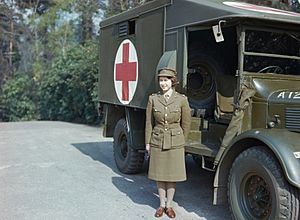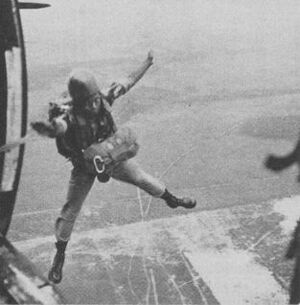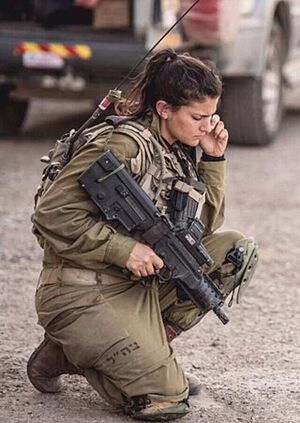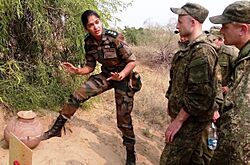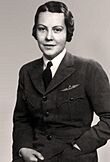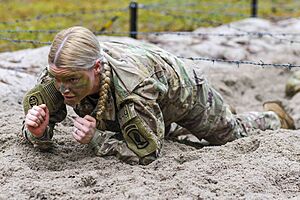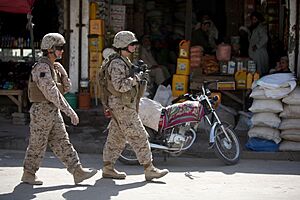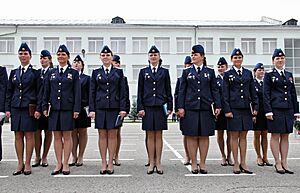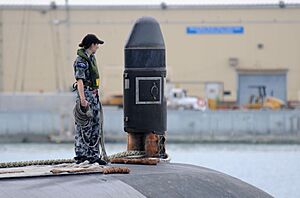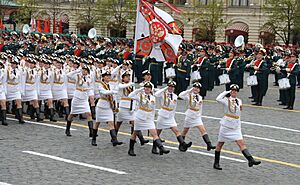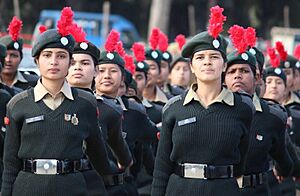Women in the military facts for kids


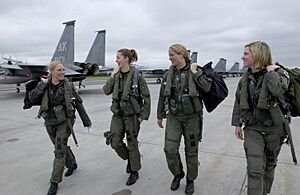
Women have always played a part in the military, right from the start of organized fighting. They have served in both combat (fighting) and non-combat (support) roles. In recent years, more women are joining combat missions. They often work as pilots, mechanics, and even infantry officers.
Since 1914, more women have been asked to join the military, especially in Western countries. They started taking on many different jobs. By the 1970s, most Western armies allowed women to serve actively in all parts of the military. In 2006, eight countries required women to join the military, a process called conscription. These countries included China, Eritrea, Israel, Libya, Malaysia, North Korea, Peru, and Taiwan.
In 2013, Norway became the first NATO country to draft women. It was also the first country to require women to serve under the same rules as men. Sweden followed in 2017, and the Netherlands in 2018. However, the Netherlands does not actively draft people during peacetime. Denmark announced in 2024 that women will be drafted starting in 2026.
As of 2022, only Norway, Sweden, and the Netherlands draft both women and men under the same rules. Denmark plans to start in 2026. Some other countries have laws to draft women, but with some differences. These differences might include who is exempt from service or how long they serve.
Today, women can serve in every job in the French military. This includes working in submarines and as combat infantry. Women make up about 15% of all military staff in France. They are 11% of the Army, 16% of the Navy, 28% of the Air Force, and 58% of the Medical Corps. This shows that women are just as important as men in both medical and combat roles.
History of Women in the Military
Women in World War I
During the First World War, women in the United States helped in many ways. They joined groups like the Committee on Public Information to teach people about the war and promote national pride. Many women became YWCA members and went overseas to help soldiers. Women from all backgrounds helped. Wealthy women started war organizations, while middle and lower-class women worked as nurses or filled jobs left by men who went to war.

Russia was the only country to send a large number of female combat troops. Historically, women joined the military in disguise or were quietly accepted. A famous example was a group of light cavalry in a Cossack regiment. From 1915 to 1917, this regiment was led by a female colonel, Alexandra Kudasheva. This group fought in WWI and during the Russian Revolution. It might have been the first mixed-gender regiment in Russian history.
Another famous woman was Maria Bochkareva. She was honored three times for bravery and became a senior non-commissioned officer. In 1917, the Provisional Government created "Women's Battalions," with Maria Bochkareva as an officer. These groups were later disbanded. In the Russian Civil War, women fought for both the Bolsheviks and the White Guard.
In Serbia, some women played important military roles. Scottish doctor Elsie Inglis helped about 8,000 Serbian troops retreat safely. Milunka Savić joined the Serbian army in place of her brother. She fought throughout the war and became one of the most decorated women in military history.
In 1917, Loretta Walsh was the first woman to openly join the U.S. Navy. A 1948 law made women a permanent part of the military. In 1976, the first women were allowed into a U.S. military academy. About 16% of the 2013 West Point class were women. During the 1918 Finnish Civil War, over 2,000 women fought in the Women's Red Guards.
During the Spanish Civil War, thousands of women fought in mixed-gender combat units. They also served in support roles or as part of militias.
Women in World War II
All major countries in World War II had women serving in their militaries. Most worked as nurses, clerks, or in support roles. Over 500,000 women had combat roles in anti-aircraft units in Britain and Germany. They also served in front-line units in the Soviet Union.
United States Women in WWII
In 1941, about 350,000 women served in the United States Armed Forces. At first, women were not seen as qualified for many jobs. However, due to the war, women started working in aircraft factories and making weapons and submarines. They were paid less than men for the same work.
Indian Women in WWII
In 1942, the Indian National Army (Azaad Hind Fauj) created the Rani of Jhansi Regiment. This was India's first all-women regiment. They fought for Indian independence with help from Japan. It is thought that over 1,000 women served in this regiment.
British Women in WWII
In 1938, the British set up uniformed services for women. By late 1941, Britain began drafting women. Most went to factories, and some joined the military. Many joined the Auxiliary Territorial Service (ATS), which was part of the army. The ATS started in 1938 and gained military status in 1941. Women in the ATS received two-thirds of men's pay.
Women played a big role in operating anti-aircraft guns against German planes and V-1 missiles. By 1943, 56,000 women were in Anti-Aircraft Command. They were mostly in units near London, where they faced danger but not capture.
German Women in WWII
Germany also had women in similar roles. Women served in support units for the navy, air force, and army. By 1944-45, about 500,000 women volunteered as uniformed helpers in the German armed forces (Wehrmacht). Many more replaced drafted men in wartime jobs. In the Luftwaffe (air force), women helped operate anti-aircraft systems. By 1945, German women held 85% of clerical, accounting, and administrative jobs.
The German nursing service had four main groups. Military nursing was mostly done by the DRK (Red Cross), which was partly controlled by the Nazis. Red Cross nurses worked in hospitals near the front lines. Two dozen nurses received the Iron Cross for bravery.
Hundreds of women also served as guards (Aufseherin) in SS camps. Near the end of World War Two, women also fought in the Volkssturm. Girls as young as 14 were trained to use small arms and hand grenades.
Japanese American Women in WWII
During Second World War, many Japanese American women lost their jobs or pay. This was because they were sent to relocation camps. Japanese immigrants and Japanese Americans faced much prejudice. Despite this, many Japanese American women volunteered for the Women's Auxiliary Army Corps.
They greatly helped the United States. Many women worked as interpreters, translators, and interrogators in the Military Intelligence Service. In 1948, the Women's Army Corps became a permanent part of the military. It lasted until 1978, when women were allowed into the regular army.
Italian Women in WWII
In Italy, during World War II, the Female Auxiliary Service (SAF) was a women's military group. All its members were volunteers. The commander was Brig. Gen. Piera Gatteschi Fondelli.
Yugoslav Partisans
The Yugoslav National Liberation Movement had six million civilian supporters. Two million of these were women who formed the Antifascist Front of Women (AFŽ). This group managed schools, hospitals, and local governments. About 100,000 women served with 600,000 men in Tito's Yugoslav National Liberation Army.
Women in the Vietnam War
Not much official information exists about female Vietnam War veterans. However, the Vietnam Women's Memorial Foundation estimates that about 11,000 military women were in Vietnam. Almost all of them were volunteers. 90 percent served as military nurses. Women also worked as doctors, air traffic controllers, and intelligence officers.
Many civilian women also volunteered in Vietnam. They worked for groups like the American Red Cross, United Service Organizations (USO), and various religious groups.
Women in the Democratic Republic of the Congo
The Democratic Republic of the Congo started training 150 women as para-commandos in 1967. Many more were trained over the years. These women received parachute and weapons training. It is not fully clear how much they were involved in combat units.
Women in Eritrea
In 1999, the BBC reported that about a quarter of the Eritrean soldiers in the Eritrean–Ethiopian War were women.
Women in Israel
In Israel, mandatory military service for single and married women without children began in 1948. At first, women served in the Women's Army Corps. They worked as clerks, drivers, nurses, and instructors. In the late 1970s and early 1980s, more roles opened up for women.
In 2000, a law called the Equality amendment gave women equal opportunities in the military. Women started to join combat support and light combat roles. This included the Artillery Corps, infantry units, and armored divisions. Special platoons called Carakal were formed for men and women to serve together in light infantry. Many women also joined the Border Police.
Despite these changes, in 2014, less than 4 percent of women in service were in combat jobs. These jobs include infantry, tank crews, artillery, or fighter pilots. Most women were in "combat-support" roles.
In 2023, the mostly-female Caracal battalion fought bravely when Hamas militants attacked near Gaza. The female soldiers fought for almost four hours. They played a key part in stopping the attack. None of the female combat soldiers were killed. This event showed that women can perform infantry missions well with the right training.
Women in the Gulf War
In 1990 and 1991, about 40,000 American military women were sent to the Gulf War. However, no women served in direct combat at that time. A rule from 1994 stopped women from being assigned to ground combat units below a certain level.
Women in the 21st Century Military
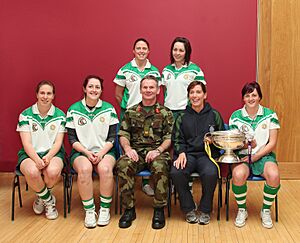
The number of women in the military varies around the world. For example, it's about 3% in India, 10% in the UK, 15% in France, 13% in Sweden, 16% in the US, 15.3% in Canada, and 27% in South Africa. While women make up a small part of global military service, predictions in 1980 thought it would reach about 10%.
In 2021, the Nigerian Army sent 300 female soldiers to protect a major highway.
Women in Combat Roles
Some countries allow female soldiers to serve in certain combat jobs. Others do not, often because of physical demands or privacy rules. Among NATO countries in the mid-1970s, women could gain military status in Belgium, Canada, Denmark, France, Germany, Greece, the Netherlands, Norway, Portugal, Turkey, the United Kingdom, and the United States.
Countries that do not have conscription, like the United States, United Kingdom, and Canada, have the highest numbers of women in their militaries. Canada is known for being very open to gender equality early on. As more people called for equal opportunities and fewer men wanted to join the military, countries started changing their rules to include women. With the opening of submarine service in 2000, women could join almost any military job.
Women in the United States Military
The United States military now allows women in all positions. However, some units, like Special Operations, have very tough requirements. Few women have met them. As of 2024, three women have finished the Army's tough Special Forces course. Two have completed Navy Special Warfare Training. One has completed Air Force special tactics courses to become a Combat Controller. Three have completed Air Force training to become a Tactical Air Control Party airman. One has completed the Air Force's tough Special Reconnaissance course.
Women have not historically been required to register for Selective Services (the draft). However, a federal judge ruled in 2019 that an all-male draft was unconstitutional. This ruling was later overturned. In 2021, Supreme Court Justices said the draft might be unconstitutional. Congress and a national commission are reviewing it.
History of US Women in Military
Women have been involved in the U.S. military since 1775. At first, they worked in civilian jobs like nursing, laundry, and cooking.
Deborah Sampson was one of the first women to join the military disguised as a man. She was not happy with her limited role in the American Revolution. She served in an infantry unit and fought in many battles. When she was injured and her secret was found out, her commanding officer honorably discharged her.
Many women helped in the American Civil War. They worked as nurses, spies, and even fought. For example, Belle Royd became a spy and messenger at age 17. She was known as the "Cleopatra of the Confederacy." She gave important information to Confederate leaders. She was arrested many times and eventually banned from federal land.
Women who fought in the war often disguised themselves as men. It was not hard to hide their identity because soldiers showered separately and wore clothes most of the time. Also, both men and women joined the army with no experience. So, their training was similar, and women did not stand out.
Sophronia Smith Hunt disguised herself as a man and fought at the Battle of Jenkins' Ferry. She fought with her first husband, who was wounded and later died.
The most common way women were discovered was through injury. For example, in 1861, Mary Owens claimed to join the Union Army disguised as her boyfriend's "brother." She said she delivered messages to commanders. After her lover died, she decided to fight. She was injured in the forehead and sent to the hospital, where her identity was revealed. She was discharged.
In 1917, Loretta Walsh became the first woman to openly join the Navy. A 1948 law made women a permanent part of the military. In 1976, the first group of women was allowed into a U.S. military academy. About 16% of the 2013 West Point class were women.
In 1990 and 1991, about 40,000 American military women were sent to the Gulf War. However, no women served in combat. A rule from 1994 stopped women from being assigned to ground combat units.
Policy Changes for US Women in Military
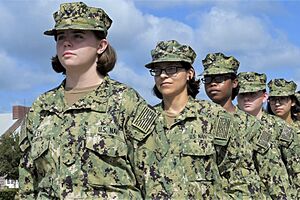
Until 1993, 67 percent of Army jobs were open to women. In 2013, 15.6 percent of the Army's soldiers were female. They served in 95 percent of jobs. As of 2017, 78 percent of Army jobs were open to women. It was only in 2015 that the Department of Defense removed its ban on women in combat roles.
In 2013, female US Army soldiers took a special training course. This course prepared them for tasks like finding unexploded bombs, collecting evidence, and searching vehicles.
By May 2015, none of the nineteen women trying to become the first female Army Rangers had passed the tough Ranger School. Two women graduated in August 2015, and a third in October 2015.
In April 2015, the Marine Corps' Infantry Officer Course ended without any female graduates. The last two female participants failed a fitness test.
In 2016, Secretary of Defense Ash Carter opened all military jobs to women. This included about 10% of jobs that were previously closed. These jobs included infantry, armor, and some special operations units.
Women have been injured, killed, and received high honors. Two women received the Silver Star for their actions in combat: Sergeant Leigh Ann Hester in 2005 and Army Specialist Monica Lin Brown in 2007. Over 10,000 combat action badges were given to women who served in combat in Iraq and Afghanistan.
In 2022, the United States Army changed its fitness test. The new test, called the Army Combat Fitness Test, now considers age and gender. This change allowed more female soldiers to meet the standards.
In February 2023, new rules were put in place to support military members.
Physical and Social Issues for US Women in Military
A 2015 Marine Corps study looked at how women performed in combat. It found that women in a special unit were injured twice as often as men. They were also less accurate with infantry weapons and less skilled at moving wounded troops.
The study involved about 400 Marines, including 100 women. Male units performed better on 93 out of 134 tasks (69 percent). Male units were faster in tactical movements, especially with heavy weapons. Male infantry squads were more accurate than mixed squads. The study found "a notable difference between genders for every individual weapons system."
Male Marines who had not received infantry training were more accurate than women who had received training. Moving wounded troops also showed "notable differences" between all-male and mixed-gender groups.
Unit cohesion (how well a team works together) was lower in mixed-gender units.
Women on Submarines
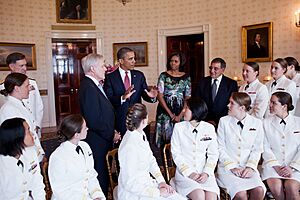
In 1985, the Royal Norwegian Navy was the first navy to allow women to serve in submarines. The first female submarine commander was Captain Solveig Krey in 1995. The Danish Navy allowed women on submarines in 1988, followed by the Swedish Navy in 1989. The Royal Australian Navy allowed them in 1998, Canada in 2000, and Spain.
On April 29, 2010, the United States Navy allowed women to serve on submarines. Before this, there were concerns about needing separate living spaces. The Navy said that larger submarines had more space and could fit female officers with few changes. Qualified female candidates were available. (At that time, women made up 15 percent of active sailors.)
In May 2014, three women became the UK Royal Navy's first female submariners.
On November 15, 2017, the first Argentinean female submarine officer, Eliana Krawczyk, disappeared in the Atlantic Ocean. This happened after the Argentine Navy lost contact with the submarine ARA San Juan. She was one of 44 crew members lost at sea.
On July 4, 2017, after two years of training, four female officers boarded a French submarine for France's first mixed-gender patrol. The next generation of French submarines is being built to include women.
Women are expected to join submarine crews in the Royal Netherlands Navy in 2019. This will involve adding shower doors and changing-room curtains.
In 2020, Risa Takenouchi became the first female student to join Japan's MSDF Submarine Training Center. This happened after rules against women submariners were changed.
|
See also
- Women in the military by country
- Women in war
- Women in warfare and the military (1945–1999)
- Women in warfare and the military (2000–present)
- Women in the military in Europe
- Women in the Philippine military
- Women in the military in the Americas
- Women in the United States Army
- Women in the United States Marine Corps
- Women in the United States Navy
- Women in the United States Air Force
- Women in the United States Coast Guard
- Women in the United States Space Force
- Puerto Rican women in the military
- List of women warriors in folklore


